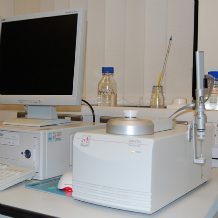Isothermal titration calorimetry
Calorimetry is the measurement of heat evolved or absorbed during a chemical or physical change in a sample. The two principal types of calorimetry of interest to biochemists are differential scanning calorimetry (DSC) and isothermal titration calorimetry (ITC). In DSC a sample is exposed to a temperature ramp; changes in the sample, e.g. denaturation of a protein, result in heat absorption which peaks at a given temperature. This method is frequently used for studying protein stability. The TF does not have facilities for DSC (see the circular dichroism pages for an alternative method of observing protein denaturation).
Isothermal titration calorimetry, as the name implies, is conducted at a constant temperature. Small aliquots of one reactant ("ligand") are titrated into a larger volume of a second component ("sample") in solution, and the resulting heat evolution/absorption is measured. The area under the heat evolution curve for each aliquot is measured and then replotted as a function of the molar ratio of ligand to sample. The resulting titration curves can be analysed to give the enthalpy ΔH of the interaction, and the association constant K, which is related to free energy ΔG; from these the entropy ΔS can be calculated. These are absolute thermodynamic measurements.
Applications
Isothermal titration calorimetry (ITC) is mostly used to measure strengths of interaction between proteins and ligands: either small molecules like drugs, or large ones such as nucleic acids or other proteins. In principle, it can be used to look at any reversible chemical interaction.
Facilities
The Molecular Interactions Laboratory has a Microcal VP-ITC microcalorimeter. This is a state-of-the-art machine and widely recognised as the standard for studies on biological macromolecules. The machine can perform experiments between ~10C and 60C. The cell is made of Hastelloy, a sort of stainless steel which is resistant to most samples (except highly acidic ones). There is also a Thermovac degassing unit for sample preparation (gas bubbles cause spikes in the heat profiles). The Microcal software converts the heat evolution traces to ΔH values and can analyse for single site binding or more complex models of interaction, and produce publication quality graphs.
Samples
In biochemical terms, ITC requires a substantial amount of material by comparison with other techniques, but modern high yield overexpression systems have made this less of a problem in recent years. Typically 2 - 2.5 ml of sample component (in the cell) at 10-100µM is required, and about 0.5 ml of the ligand (in the syringe) at ten-fold higher concentration. This corresponds to milligram quantities of protein. Lower or higher concentrations might be necessary depending on the strength of binding.
For ITC, as for AUC, the importance of sample preparation cannot be overstated. The machine measures the heat change on mixing the ligand solution with the sample solution - so anything that contributes to this heat will be included in the result. Besides the ligand-sample interaction, heat changes can arise from dilution of salts or glycerol, from buffer neutralisation where there is a pH difference, from precipitation, from oxidation or reduction of DTT, and various other sources. To minimise such interference the best approach is to dialyse both ligand and sample against the same buffer before the experiment. (Concentrations should then be determined after dialysis.) Where this cannot be done, it may be necessary to conduct control titrations of ligand into buffer or buffer into sample and subtract the residual heats from those measured in the interaction experiment.
Links
- Microcal (manufacturer of the VP-ITC calorimeter)
- BBSRC/EPSRC Biological Microcalorimetry Facility (Prof. Alan Cooper, Glasgow Biophysical Chemistry Group)


